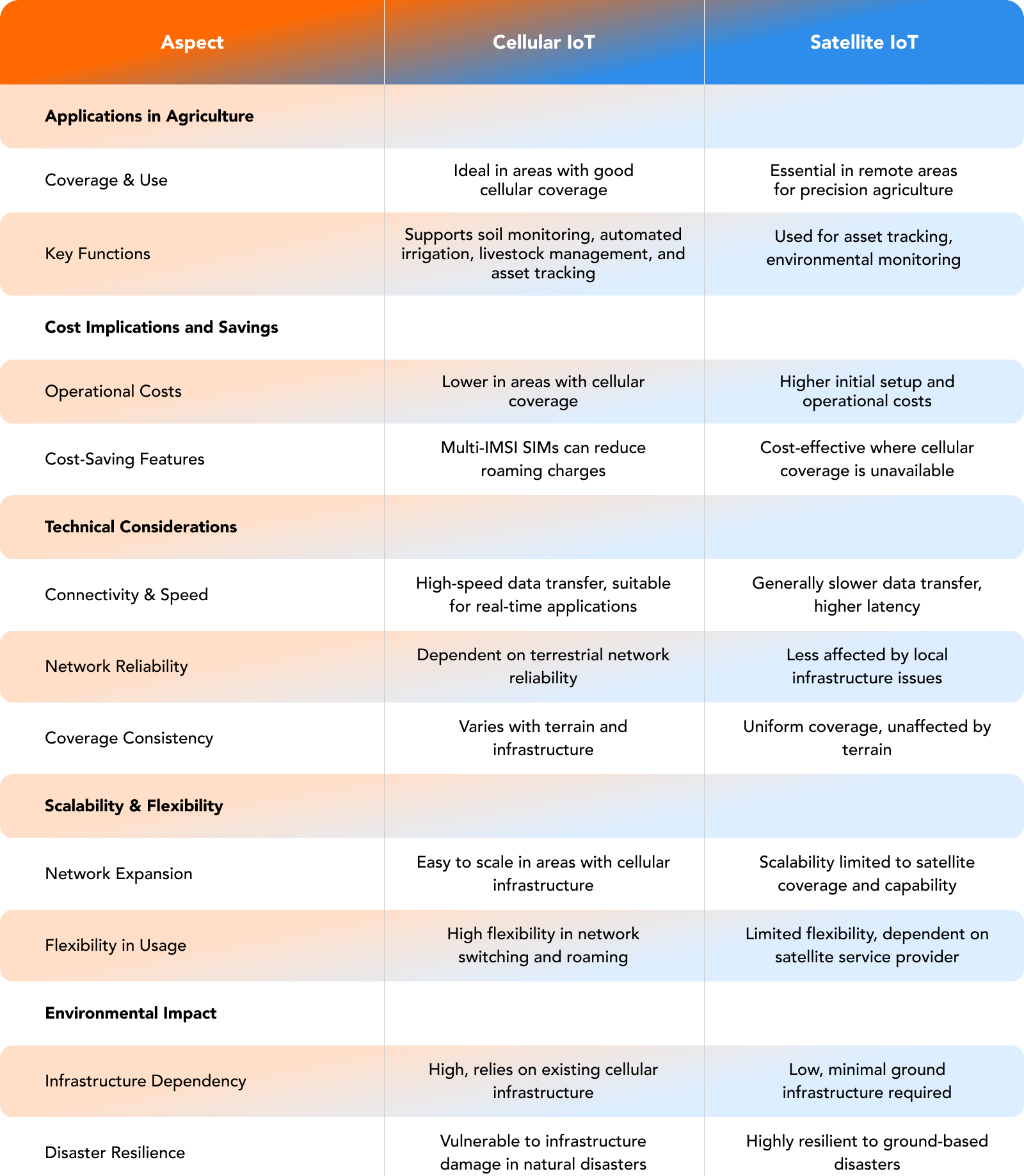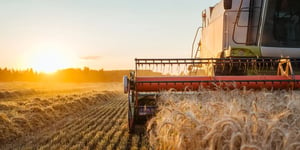The integration of Internet of Things (IoT) technologies in agriculture is revolutionizing the sector, offering unprecedented opportunities for efficiency, productivity, and sustainability. This evolution shines through in the side-by-side comparison of Cellular IoT and Satellite IoT services. Each technology brings its own advantages and challenges, perfectly suited to address the varied requirements of today's farming industry.
Cellular IoT connectivity uses advanced Multi-IMSI SIM cards to offer flexibility, affordability, and the ability to transmit data instantly. This improves everything from managing global supply chains to precision farming across different landscapes. Meanwhile, Satellite IoT services provide connectivity to the most isolated areas, making sure every part of the farm is well-monitored and managed, even where ground networks can't reach.
This blog post explores the balance between Cellular IoT and Satellite IoT technologies. We'll show how using them together tackles modern agriculture's challenges and sparks innovation and growth. By comparing these technologies and sharing practical insights, we aim to highlight how agricultural businesses can use them to improve reliability, productivity, and save costs. This marks a new phase in the technological progress of the sector.
Cellular IoT Connectivity with Multi-IMSI SIM in Agriculture
Strengths:
Global Roaming and Network Flexibility: Multi-IMSI SIM cards excel in network flexibility, essential for agriculture businesses operating internationally. These SIMs enable IoT devices, like sensors and machinery, to switch seamlessly between network operators, maintaining connectivity across borders. This is crucial for consistent data flow and monitoring of crops and livestock in cross-border operations. For businesses in international agriculture, this means reliable data access everywhere, enhancing efficiency in global supply chains.
Improved Domestic Connectivity: Multi-IMSI SIM cards are very useful even within one country, especially for farms in rural or remote areas. They enable agricultural IoT devices to automatically switch to the strongest network operator available. This is important in areas with poor signal strength to keep devices such as soil sensors and weather stations connected.
This steady connection is vital for smooth data gathering and running the farm well. It lets farmers get and use data and control systems reliably, anywhere on their farm. Such uninterrupted network access boosts the efficiency and reliability of agricultural operations.
Cost-Effectiveness in Network Areas: Multi-IMSI SIM cards are cost-effective in areas with good cellular signals, especially for tasks that use a lot of data, like sending pictures from the field or data from sensors. Their efficient use of available networks significantly reduces operational costs. This makes things more affordable for farmers and agricultural businesses. It helps them manage their budgets better and spend less on sending data, making it easier and more sustainable to use technology over time.
Real-Time Data Transmission: In modern farming, making quick decisions is crucial, and having cellular connectivity with multi-IMSI SIM cards helps a lot with this. They enable real-time data transmission, vital for precision farming.
With sensors in equipment and across the farm, immediate data on soil moisture, crop health, and weather is sent. This allows farmers to make timely decisions like when to irrigate or harvest. This speed in information flow boosts operational efficiency, crop yields, and sustainability, making farming more profitable and environmentally friendly.
Weaknesses:
Limited Coverage in Remote Areas: Multi-IMSI SIM cards don't work in remote and rural farming areas with no cellular network coverage. This is a notable challenge in less developed or hard-to-reach areas. For farmers in these areas, not having a reliable network means they can't fully use IoT benefits, such as real-time monitoring and precision farming. This connectivity gap can hinder the optimization of farm operations, impacting productivity and efficiency.
Dependence on Terrestrial Infrastructure: Multi-IMSI SIM cards' reliance on ground networks can be a drawback. Issues like service outages, maintenance, or damage from natural disasters can disrupt connectivity. In agriculture, this means potential delays in crucial data and difficulty controlling IoT machinery, risking losses and inefficiencies. This highlights the need for backup connectivity solutions in areas facing environmental challenges or with weak network infrastructure.
Satellite IoT Services in Agriculture
Strengths:
Global Coverage in Remote Areas: Satellite IoT services provide essential connectivity in remote and rural agricultural regions where cellular networks are limited. This is vital for isolated farms or areas with underdeveloped cellular infrastructure. Satellite connectivity enables these distant operations to access IoT technology for data collection and communication, key for modern farming. It helps with checking soil health, weather, and crops, letting even very remote farms make smart decisions based on data.
Uniform Coverage Across Varied Terrains: Satellite IoT services provide steady coverage for all types of farm landscapes, whether it's hilly areas, large plains, or places with lots of plants. This uniform connectivity is crucial for large farms where cellular signals might be weak or absent. Satellite IoT ensures every part of these extensive operations is monitored and connected, enabling efficient and effective farm management.
Reliability in Diverse Conditions: Satellite IoT services are highly reliable, even when ground infrastructure is compromised by construction, development, or natural disasters. This resilience is crucial in agriculture, ensuring uninterrupted connectivity and data access in adverse conditions. For farmers, this reliability means their IoT systems stay operational, offering steady data and insights for smooth farm operations.
Weaknesses:
Higher Costs for Equipment and Data Transmission: Satellite IoT services often come with higher costs than cellular options. This includes the initial outlay for specialized satellite equipment and higher operational expenses, particularly for data transmission. These costs can be burdensome for small-scale farmers or businesses with limited budgets. Despite offering extensive coverage, the financial commitment for satellite connectivity can be substantial, making it a less viable option for some agricultural operations.
Higher Latency in Data Transmission: Satellite connections typically experience higher latency than terrestrial networks. This can be a problem in farming, especially for tasks that need fast responses, such as automatic watering systems or quick weather checks. In precision farming, where prompt decision-making is key, latency can impact operational efficiency. Despite its reliable coverage, satellite connectivity's latency is a factor to consider in time-sensitive agricultural applications.
Characteristics Comparison: Cellular vs Satellite

Combined Use and Cost-Saving Strategies
Hybrid Solutions:
Using a mix of cellular and satellite IoT technologies offers a strong solution that meets the different needs of the farming sector. This strategic combination ensures comprehensive connectivity across different farming environments.
- Optimized Coverage: Employ cellular IoT in areas with reliable network coverage to benefit from its high-speed data capabilities and cost efficiency. This is ideal for farm operations close to developed regions or within well-connected rural areas.
- Extended Reach: On the other hand, use satellite IoT in remote or hard-to-reach places where cellular networks are not available. Satellite connectivity shines here, offering crucial data transmission capabilities that keep these distant operations connected.
- Cost-Saving Practices: By using cellular IoT where it works best and adding satellite IoT where necessary, farms can cut down a lot on their operating costs. This focused method helps avoid spending too much on satellite technology in areas where cellular solutions are enough. It also makes sure that remote areas still get the vital connectivity they need.
- Enhanced Reliability and Productivity: The hybrid model guarantees ongoing connectivity across different farming landscapes. It also boosts the reliability and productivity of farm operations. It enables a seamless flow of data, crucial for precision agriculture practices, resource management, and decision-making processes.
Using this two-technology approach leads to smarter, more efficient, and cheaper farming methods. This matches well with the changing needs of modern farming.
Cost-Saving Tips:
Besides using multi-IMSI SIMs and managing satellite data well, there are many other ways to save costs in agricultural IoT:
- Data Management and Analytics: Implement advanced data management systems to analyze and compress the data before transmission. This can significantly reduce the amount of data sent over satellite networks, thereby lowering costs.
- Smart Scheduling of Data Transmission: Schedule data transmission during off-peak hours for satellite services, if possible. Some service providers offer lower rates during these times, which can lead to cost savings.
- Use of Local Data Processing: Process data locally as much as possible. Using edge computing to process data right on the farm can cut down the amount of data sent over networks, which helps save money.
- Regularly Review and Adjust Plans: Continuously monitor and review your connectivity usage and needs. Adjust your plans and strategies accordingly to avoid unnecessary expenditures on data or services you don’t need.
- Invest in Efficient Equipment: Ensure that your IoT devices and equipment are energy-efficient and durable. Buying high-quality equipment might cost more at first, but it can save money over time by lowering the need for repairs and replacements.
By combining these strategies with multi-IMSI SIMs and smart management of satellite data, agricultural businesses can make their IoT use more efficient and keep costs in check. This way, they get the most out of their technology without overspending.
Conclusion
In the fast-changing world of farming, using both cellular IoT with multi-IMSI SIM cards and satellite IoT services is more about how they work together than picking one over the other. Each one has its own benefits and challenges. Knowing this helps in creating a good connectivity plan.
Farmers and agricultural businesses can benefit greatly from a hybrid approach. Cellular IoT, with its cost-effective and high-speed data capabilities, serves well in areas with strong network coverage. On the other hand, satellite IoT covers important needs in remote or difficult areas, making sure every part of the farm stays connected. This combination not only enhances the overall operational efficiency but also drives sustainability, a crucial aspect in today's agriculture.
Moreover, adopting such an integrated approach paves the way for innovative farming techniques. The combination of cellular and satellite IoT turns data into useful insights for precision farming and smart resource management. This leads to smarter decisions and better results.
In conclusion, the intersection of these two technologies marks a new horizon in agricultural connectivity, where efficiency, sustainability, and cost-effectiveness converge. By using both cellular and satellite IoT, the farming sector can handle modern farming's challenges and move towards a more connected and productive future.
At POND IoT, we understand the importance of mainintaining realiable and seamless connectivity. With our SMART SIM (aka mulit-IMSI SIM) we offer 5G across the three largest nationwide networks in the US on a single profile on one SIM. Apart from this, with our SIM you will have access to 800+ partner networks across the globe.
We are also an Authorized Peplink & Starlink Solution Provider, learn more here.
Contact us to learn more!

